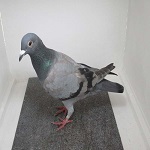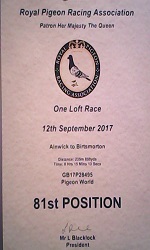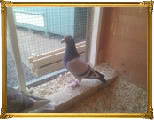| Countrywide Corns |  |
| Forum Syndicate 2019 | Pigeon World Forum Syndicate Bird takes 44th Place, in the 2019 RPRA One Loft Final.The Bird is Frans Zwol Bloodline, Bred and supplied by Darren Palmer (Oldstrain)  |
| Forum Syndicate 2019 | Pigeon World Forum Syndicate also takes 100th Place, in the 2019 RPRA One Loft Final. The Bird is Frans Zwol Bloodline, Bred and supplied by Darren Palmer (Oldstrain)

|
| Who is online? | In total there are 78 users online :: 0 Registered, 0 Hidden and 78 Guests :: 1 Bot None Most users ever online was 833 on Wed Nov 10, 2021 12:30 pm |
| Forum Syndicate 2017 | Pigeon World Syndicate Bird takes 81st Place in the 2017 Final Race, The Bird is Dia Evans Bloodlines and was Bred and supplied by Tumley Lofts Stud.  |
| R.P.R.A Certificate. | Pigeon World Forum Syndicate take 81st Place in the 2017 R.P.R.A. Final, with a Pigeon Bred and Supplied by Tumley Lofts Stud. |
| Top posting users this week | |
| Statistics | We have 1297 registered users
The newest registered user is tharunjohar50
Our users have posted a total of 222738 messages in 14003 subjects
|
| Oldstrain/Darren`s Winner of winners. 2012. |  |
| From Fed Topper to Master Chef |  The N.E.H.U race from Melton Mowbray 21/4/2012 was won by Peel bros of South Shields, they took 1st club 1st fed, also taking 2nd and 4th club and 15 of the 25 birds clocked in the club......well done Peel brothers. The N.E.H.U race from Melton Mowbray 21/4/2012 was won by Peel bros of South Shields, they took 1st club 1st fed, also taking 2nd and 4th club and 15 of the 25 birds clocked in the club......well done Peel brothers. |
| | | Segments of the eye......by Jack Barkel. |  |
| | | Author | Message |
|---|
Admin
Admin


Posts : 299
Join date : 2009-03-11
 |  Subject: Segments of the eye......by Jack Barkel. Subject: Segments of the eye......by Jack Barkel.  Wed Jun 10, 2009 1:19 pm Wed Jun 10, 2009 1:19 pm | |
| Pupil & Correlation. I have had several requests to explain with illustrations the different segments of the eye as used in evaluating racing pigeons. This I propose to do for those members who have shown a genuine interest in the eye. I do not intend to try and persuade any person to adopt my beliefs, I have been requested to reveal what I see as important in eye sign recognition, and hope I can meet this request without any harassment. I think it is time for me to present a project in a series, to explain and categorise the parts of the eye that are used in eye sign, and some in iridology. Not to confuse, we will refer to the sections of the eye under the popular names used in eye sign. ******************** Here we have an illustration of an eye previously illustrated, only we have removed all the granular circles or humanly made circles and only retained the two basic circles, which are the pupil and the correlation. Now once we have added the adaptation the correlation then becomes the third visible circle of the eye. It is however much larger than can be seen when the eye is complete for as you can see by this illustration it stretches from the pupil to the outer perimeter of the eye. Now this correlation is similar to a pigmented gel, in this case a yellow base. It is designed in the shape of rods going down into the eye and it varies in density and depth. This can often be diagnosed by the excess making clusters, which we will explain later. Therefore it is important we realise the correlation is the foundation or base structure of the genetic imprint on the eye. This is the only part of the eye structure which is my own theory, you will not find the correlation written or shown in full, anywhere else other than under my own pen. I take every credit for it, and I know from my own experiments that it is factual. ********************************* Now we come to the pupil muscle which as been misnamed and even called the eye sign or adaptation, let me assure you it is neither of these and this misunderstanding has been the lack of progress in many budding eye sign enthusiasts. We can see that the arrow point in the illustration overlaps the beginning of the correlation, I have done this purposefully because that is what this pupil muscle does, it overlaps onto the correlation in most cases right around the edge of the pupil and because of its similar black density in colour to the pupil, it is not easily recognised. We must not judge this sphincter muscle with an eye glass. It has a characteristic, that if it is clearly visible in width it can be very shallow in depth, and if it is not clearly visible in width, it is most often very strong in depth. This is why this muscle cannot be judged visibly by its appearance. The function of this muscle is similar to that of the shutter on a camera lens, it dilates and contracts the pupil to the intensity of light. So if you put the eye into a reasonably bright light you should see a reaction of the pupil which is controlled by this pupil muscle. The Nederland fanciers call it the Verkenning Sirkel, in English it is known as The Circle Of Recognition. I prefer to call it the pupil muscle. You will find that birds who do not possess a reactive pupil fly close to the ground, and those who have a reactive pupil can rise to great heights and seek a helpful wind that will improve their speed on their journey home. Caution here, thirst, anti-biotic and other medication can cause a temporary dysfunction of this particular muscle. Once again I will welcome questions if one is not sure of what I am trying to put across here. No one in the world as far as I know has gone into as much detail as I am prepared to do. I suggest those interested grab this opportunity, for I am sure it will eventually become acceptable common knowledge throughout the pigeon world. Until that day I will have to accept the criticism of some who find it destroys much of their previous beliefs on eye sign or iridology. Nearly forgot to mention the sex drive in a pigeon can also cause a rapid contraction of the pupil, it will be noted that when a cock bird shows strong interest in a hen, his pupils contract to pin points. I will present a series of examples, which are all part of one particular eye, except for the composite sign which when we arrive at that point I will explain. There will be seven illustrations in all. Next project, "The Adaptation". I will continue Article 2. after these explanations are completed. Please bear with me. Regards Jack jackbarkel@mweb.co.zahttp://mysite.mweb.co.za/residents/jackbarkel/ |
|   | | Admin
Admin


Posts : 299
Join date : 2009-03-11
 |  Subject: Re: Segments of the eye......by Jack Barkel. Subject: Re: Segments of the eye......by Jack Barkel.  Wed Jun 10, 2009 1:21 pm Wed Jun 10, 2009 1:21 pm | |
| The Adaptation. We now discuss the adaptation, this circle is located just outside the pupil, please refer to the example. The width of the circle is variable from pigeon to pigeon, but as long as it matches up in width and colour to the perimeter or fifth circle this does not matter. The circle of adaptation in this particular case is a Yellow Clear, one can have enhancements of gold and green, and when in a pearl eye which is pale pink, we can have enhancements of white, grey, violet, and even charcoal. I will at a later stage put up some photographic examples of these enhancements in the two basic colours. I must emphasise that the adaptation can be made as wide as you wish, for it is of human design and selection. It is wise not to make it wider than the fifth circle, as this will throw the balance of the genes in the wrong direction. I wish to point out at this stage that this part of the eye is linked to the well being of the pigeon, for the outer edge of this adaptation is known in iridology as the nerve wreath. Its detail will show you problems stemming from the digestive tract of the stomach, and with practice and much observation you can also study the bowel and other organs. This is straying from eye sign but I am just making you aware that such problems can be diagnosed in the eyes of our pigeons. I do not wish to transgress into the realms of homeopathy / iridology, there are people more qualified than myself in this department for anyone interested. I myself will stick to eye sign selection. The adaptation is often super imposed with an overlay of composite, which we will discuss next time. I hope you are all still with me, if anyone is not sure, please ask and I will do my best to answer before proceeding any further. Jack Barkel jackbarkel@mweb.co.zahttp://mysite.mweb.co.za/residents/jackbarkel/ |
|   | | Admin
Admin


Posts : 299
Join date : 2009-03-11
 |  Subject: Re: Segments of the eye......by Jack Barkel. Subject: Re: Segments of the eye......by Jack Barkel.  Wed Jun 10, 2009 7:18 pm Wed Jun 10, 2009 7:18 pm | |
| I now wish to portray the composite which is super imposed on the adaptation, the particular eye we are using did not have any composite, just a yellow clear adaptation as seen in the previous illustration. I have however shaded in a 40% composite on one illustration, and a 100% composite on the other. This composite is known as the racing sign and comes in various shades from grey to deep black. The shades of grey are referred to as "dilute" and the deep black as "super imposed". I have found that when pairing birds together it is best if the addition of the composite signs of a matched pair do not exceed 100%. I prefer two 30 0r 40% composites together. One must take care that if one has a pigeon they wish to breed from that has a 100% composite, then this bird should be paired to a Clear of the opposite colour eye. If we put two 100% birds together we may breed a top racer, but that is all in most cases, in other words a pure sport. That is why many people advocate putting winner to winner, for if they were flying machines we will find that very often they possessed 100% composite signs. Many fanciers on making this discovery think they have hit on the greatest revelation of all time eye selection. Soon their new team of winners using this formula degenerate into little of value. If it were not so, I could pair up your birds to breed winner after winner and stock birds to match. Unfortunately there is no loft that can maintain a constant high success rate putting winner to winner or excess composite together. Be prepared if attempting this, to experience short lived joy and thereafter plenty disappointments. Therefore I would suggest that you treat the composite as a serious factor and use it as a long term tool, and not as a short term benefit. If you pair an adaptation that is Clear to a similar adaptation, you will in the main breed birds with little racing quality but good stock producers,although once again I must add that a few may pop up out of the gene pool with racing ability. Vice Versa, if you pair birds together with over an addition of 100% composite you will produce mainly racers with little breeding ability,although once again a dual purpose racer breeder may at odd times pop up from such a concentrated gene pool. Genetics have played worse tricks than this when we get involved in the art of breeding. Nothing is written in stone, but be prepared how accurate can be the advise I am giving here. Again I am here for anyone that would wish me to elaborate on any particular aspect of what we have discussed up until now. Regards jackbarkel@mweb.co.zahttp://mysite.mweb.co.za/residents/jackbarkel/ |
|   | | Admin
Admin


Posts : 299
Join date : 2009-03-11
 |  Subject: Re: Segments of the eye......by Jack Barkel. Subject: Re: Segments of the eye......by Jack Barkel.  Wed Jun 10, 2009 7:19 pm Wed Jun 10, 2009 7:19 pm | |
| We now come to the fifth circle or breeding circle, and in the illustration we can see that it is the same colour and width as the adaptation. The bird with this eye was a prolific breeder and although it displayed no composite sign it was a double winner. I do believe from my breeding records over the years that it is very important to have the adaptation and fifth circle as near in colour and width to each other as is possible. It is very difficult to produce anything perfect when breeding anything that has been interfered with by humans, but it is possible to get very close to perfection. The closer I have come to producing well balanced eyes, the greater my successes have been. We will deal with the iris next, then display this eye when it is complete. Regards jackbarkel@mweb.co.zahttp://mysite.mweb.co.za/residents/jackbarkel/ |
|   | | Admin
Admin


Posts : 299
Join date : 2009-03-11
 |  Subject: Re: Segments of the eye......by Jack Barkel. Subject: Re: Segments of the eye......by Jack Barkel.  Wed Jun 10, 2009 7:21 pm Wed Jun 10, 2009 7:21 pm | |
| We now come to the final segment of the eye, which is the iris. This is the fourth circle and like the adaptation and composite is controlled by our breeding techniques, for its width and texture is of human design. The iris comes in various depths and shades of colour, but the basic colours are deep pink, known as the genetic pearl, and orange red known as the genetic yellow. There are two ways we can observe degeneration from the perfect racer / breeder when viewing this particular portion of the eye. If the iris is becoming too wide or broad, it will eventually dominate the whole eye, covering most and sometimes all of the correlation and fifth circle. This will indicate a major drop in vitality and speed, but a gain of increased stamina. These are usually long distance homers that are hard to lose but often seem to be just out of the clock. They can be consistent, but very rarely can they be called a winner. As we showed in Article 1. of this thread, if the iris becomes too thin, the correlation can be seen to be breaking through the iris. It may be seen as a widening of the correlation and or a widening of the fifth circle, with several breaks in what should be a solid iris ring. This will indicate that one is breeding towards pigeons with reduced stamina and intelligence( homing ability) These are blow home pigeons with increased speed, but if it cannot stay in the pack it will invariably get lost. These are short distance pigeons that can be consistent for several weeks, until they eliminate themselves and never return. The attachment shows the iris of this pigeon to be of even and strict proportions, and it should be the aim of all of us to try and breed to similar parameters as this illustration. The answer to controlling this genetic drift is to breed the iris so that it does not dominate the eye, neither do we want to make it so thin, that the eye is dominated by everything else. Regards jackbarkel@mweb.co.zahttp://mysite.mweb.co.za/residents/jackbarkel/ |
|   | | Admin
Admin


Posts : 299
Join date : 2009-03-11
 |  Subject: Re: Segments of the eye......by Jack Barkel. Subject: Re: Segments of the eye......by Jack Barkel.  Wed Jun 10, 2009 7:22 pm Wed Jun 10, 2009 7:22 pm | |
| The iris although only one integral part of the five points of the eye, is the easiest to recognise if one is drifting in or out of genetic control. We will soon become expert if we pay strict observation to these points. Each small facet of the eye is important in our observations but these points are the basics to watch out for, and will serve you in good stead in selection of your stock birds. I put the eye in its completion on here to show you with all the arrows what this eye looks like when complete. One can observe a slight darkening of the fifth circle to that of the adaptation. Unfortunately the flash did not give the same light intensity for the full expanse of the eye, darkening a little towards the outer extremities. For those interested it is the eye of a Slimme Cock named " The Bill Carney Cock" named after that great eye sign man in England of the same name. The bird was a 1988 pigeon and passed on Christmas week 2006, a sad loss although infertile for a few years. It father is still alive in the loft today, although fragile he is 22 years old. Regards jackbarkel@mweb.co.zahttp://mysite.mweb.co.za/residents/jackbarkel/ |
|   | | Sponsored content
 |  Subject: Re: Segments of the eye......by Jack Barkel. Subject: Re: Segments of the eye......by Jack Barkel.  | |
| |
|   | | | | Segments of the eye......by Jack Barkel. |  |
|
Similar topics |  |
|
| | Permissions in this forum: | You cannot reply to topics in this forum
| |
| |
| |
